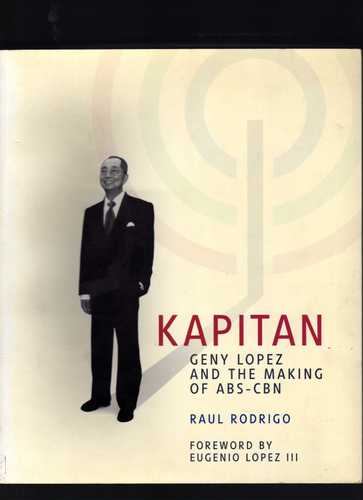Eskapo, The Movie.
Set during the terrifying reign of Filipino despot, Marcos, two upper caste but very different strangers team up to try and survive the physical and mental torture they undergo after they are suddenly jailed. Geny is the conservative businessman while Serge is more sensitive and outgoing. Both of the young men's parents give all of their money, but the government refuses to free them. Even a mutual hunger strike fails to move their jailers. In desperation, Geny and Serge begin plotting their escape. ~ Sandra Brennan, Rovi

*Eugenio Lopez, Jr. (November 4, 1928 - June 29, 1999), popularly known as Geny and Kapitan, was the Chairman Emeritus of ABS-CBN Broadcasting Corporation.
His uncle, Fernando Lopez became Vice-President of the Philippines. His father, Eugenio Lopez, Sr., was the owner of the publication Manila Chronicle and Chronicle Broadcasting Network. His mother, Pacita Lopez, the wife of Don Eugenio Lopez Sr. In 1956, he purchased equipments for the radio and television in ABS-CBN which it is family owned. He would later lead this company as its President, until 1972, when Philippine President Ferdinand Marcos declared martial law, curtailing the free press and had all media outlets shut down.
Geny was then imprisoned in Fort Bonifacio as a tactic by Marcos to acquire the properties of the Lopez family. While he was incarcerated, his mother alongside his family advocated for Geny’s freedom. His father also died during this time. After the 1986 People Power revolution, he re-acquired ABS-CBN and re-established it to become a prominent media conglomerate in the Philippines.
He died of cancer in the morning of 1999 in Quezon City. Leaving the legacy as the "Father of Philippine Broadcasting". One of the buildings inside ABS-CBN was named after him as to show how much people from ABS-CBN pay tribute to the once known for them as "Kapitan". His son, Eugenio Lopez III became Chairman and CEO after his father’s passing.
Other Information
Name: Eugenio Lopez, Jr.
Also Known As: Geny and Kapitan
Birthday: November 4, 1928
Died: June 29, 1999
Father: Eugenio Lopez, Sr.
Mother: Pacita Lopez
Uncle: Fernando Lopez
Son: Eugenio Lopez III
**Serge Osmeña III has earned the reputation of being the Senate's fearless fiscalizer. Known to be fiercely independent, he has earned the respect of many for his numerous exposes on graft and corruption, among others the anomalous IMPSA-CBK, PIATCO, Tiwi-Makban, Marconi and Casecnan contracts, saving billions of pesos for the Filipino people. During his first year in the Philippine Senate in 1995, he was already recognized by the Free Press magazine as "Most Outstanding Freshman Senator" for this exposes.
During martial law, Sen. Sergio Osmeña III was unjustly imprisoned for five long years, In November 1974, he embarked on a hunger strike, along with his cellmate Geny Lopez, to protest the unjust detention of thousands of innocent Filipinos. This resulted in the release of 1,022 political prisoners in December 1974. Defiant to the very end, Sen. Osmeña III and Mr. Lopez subsequently executed a daring escape from their maximum security prison cell in Fort Bonifacio. This exploit was immortalized in the movie, "Eskapo".
Sen. Serge R. Osmeña III is a farmer and businessman by training and was educated at Harvard, Georgetown, and the University of the Philippines. He is married to Bettina Mejia Lopez of Iloilo, Pampanga, and Leyte and has six children.





 A look at Ayala Museum’s Gold of Ancestors exhibit showcasing the gold accessories that were found in Surigao in 1981. The collection is proof of the country’s rich culture and the gold artifacts are evidences of the ancestors’ seamless craftsmanship. Unfortunately, some of the country’s important gold treasures, like the Golden Tara (ancient statue of the Hindu-Malayan Goddess that was found by a Manobo woman in Agusan in 1971), are now in the possession of other international museums;
A look at Ayala Museum’s Gold of Ancestors exhibit showcasing the gold accessories that were found in Surigao in 1981. The collection is proof of the country’s rich culture and the gold artifacts are evidences of the ancestors’ seamless craftsmanship. Unfortunately, some of the country’s important gold treasures, like the Golden Tara (ancient statue of the Hindu-Malayan Goddess that was found by a Manobo woman in Agusan in 1971), are now in the possession of other international museums;